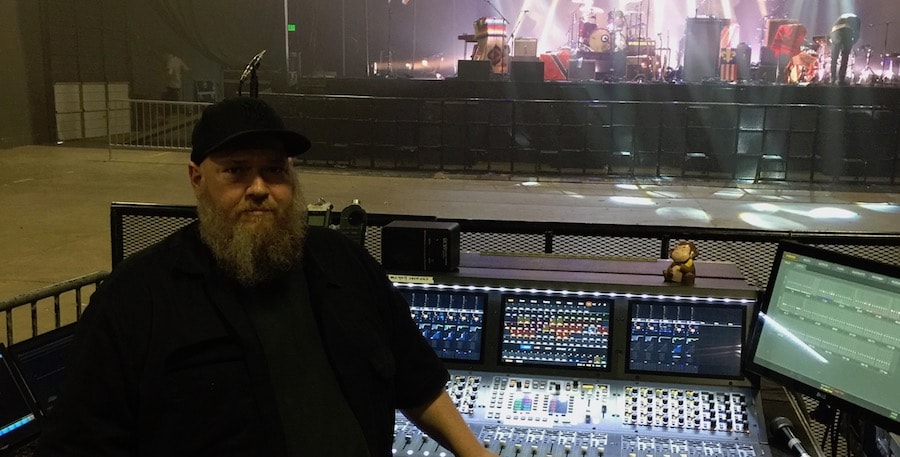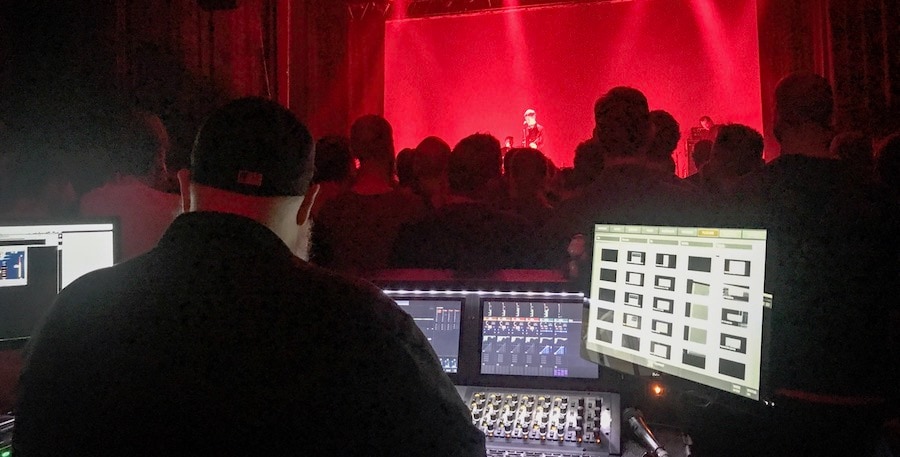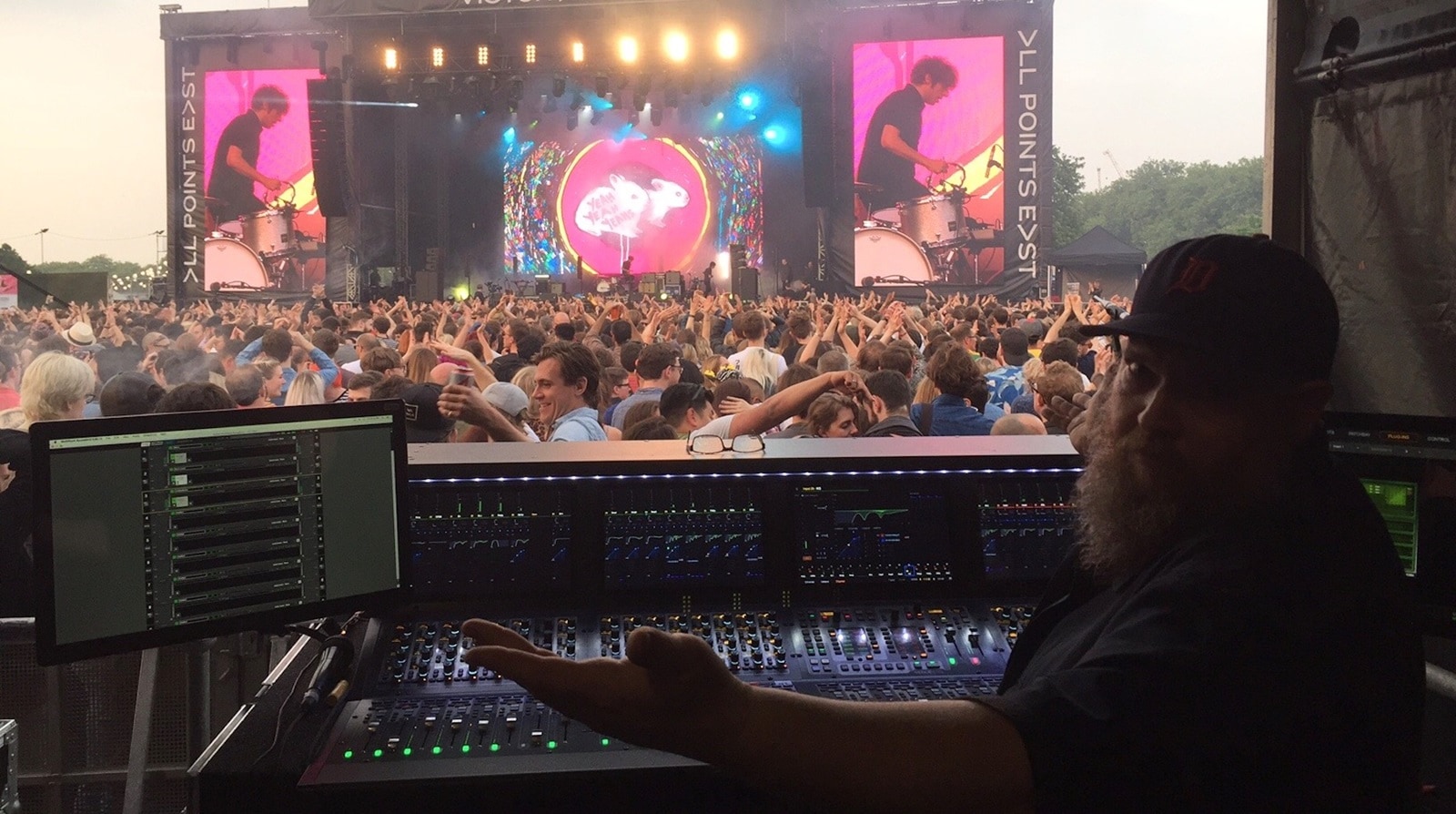

With over 20 years experience mixing live shows, Harley Zinker has mixed a diverse range of artists across many genres, including Interpol, Yeah Yeah Yeahs, Young the Giant, The Strokes, The Killers, and more. Avid had a chance to speak with Harley between tours about a range of topics, from his history with VENUE consoles and using the S6L, to his favorite plugins and how he uses Pro Tools.
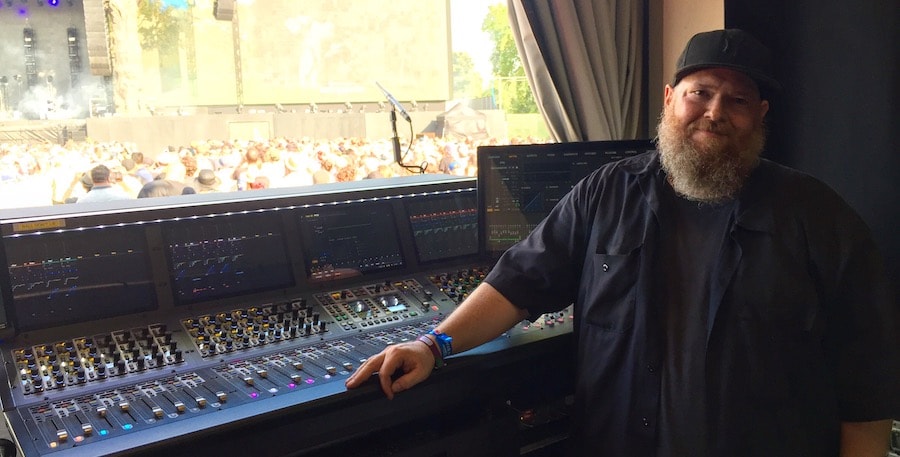
Harley Zinker
When did you start mixing on VENUE systems?
I've used digital consoles for a long time. I started on a PM1D and then PM5D, and then PM5D with a lot of outboard gear. And at that point I was working with Interpol and we were using Firehouse Productions in Northern New York. Firehouse had some of the first VENUE D-Show systems that I had ever seen. So when I was gearing up for a new tour, and had a couple of weeks of rehearsals, I said, “All right, I will give it a shot and use it this time to see if it's what right for me and what's right for my artist.” My whole attitude was I just want to replicate what I'm using in terms of outboard gear with what plugins are available and take it from there. My biggest concern at the time was trying to find something that sounded like a BSS 901.
I was pretty much sold after about the first day or two and did a couple of runs on a full-size D-Show with sidecar. Then I heard rumors of the Profile, this smaller format console coming out. So I got one of the earliest Profiles from Firehouse as well. I spent probably nine years on the D-Show and Profile combined before eventually moving over to the S6L.
I remember rolling into small clubs and theaters, and people had just never seen a Profile before, so I kind of felt like an ambassador in many ways. I sat down with many a house engineer and gave them the nickel tour and the test drive. I've been on the system for quite a while now.
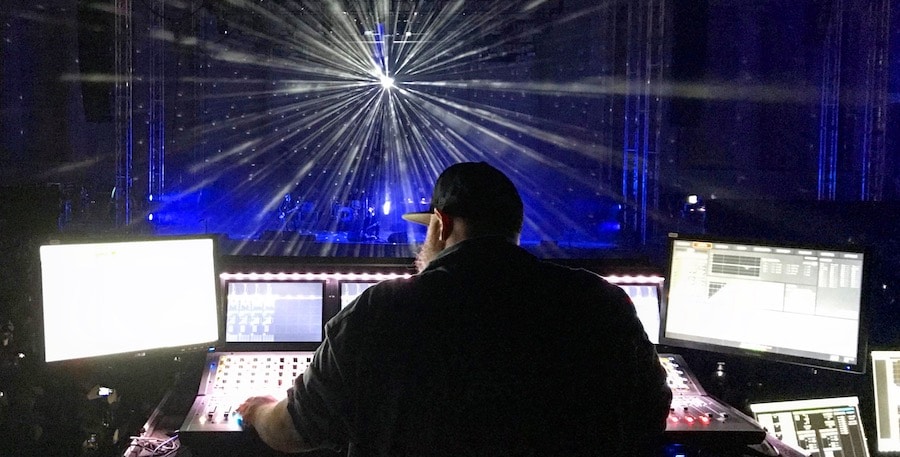
When did you transition over to S6L?
That was with Young the Giant. We were doing a bunch of one-offs, and they were getting ready for a record release and gearing up for a proper tour. We had two weeks of time at Clair in Nashville for rehearsals and I figured that would be the perfect time. I had an S6L-24, as did Ricky Leon, the monitor engineer at the time. I had nine years worth of muscle memory from the Profile, so I wasn't a hundred percent on the first day, but by the second day I was beyond a hundred percent and was completely in love with the console at that point. I finished off the two weeks of rehearsals there, did a year's worth of touring with Young the Giant with the S6L, and then went on to use it with Interpol and Yeah Yeah Yeahs.
What about the S6L appealed to you most?
96kHz is a big difference—that's something that you can hear, especially since we're driving a lot of PAs via AES these days. There were many instances where I'd be sample rate converting via another device to get into a PA. So now being at 96kHz, I can go right into most modern PAs.
But the biggest thing for me with the S6L compared to the Profile is how I can push everything to groups and then push groups to left and right. And the way in which the groups pan to left and right on the S6L, there's just a significant difference. I can hear things on the S6L that I just couldn't hear on the Profile. I'm able to maintain a lot of that separation, and things sound discrete and in focus in a way that I didn't know that I was missing that until I really heard it. That's the major thing.
On top of everything, there's the new preamp—there's an air and a top end to it that I didn't hear on the Profile. The EQ is substantially more responsive, and the same thing goes for the channel strip compressor and dynamics. Interpol keeps the stage fairly similar tour to tour in terms of instrumentation and I'm fairly conservative in terms of how I change microphones out. So the sources stay basically the same. I know what they should sound like with headphones. I know what they should sound like through a PA. As soon as I heard that first kick drum hit and that first snare and vocal through an S6L through a PA that I've been working on for a while, I could immediately hear the difference. I was just so happy—I can't even put it in words!
Aside from the sound quality being so much better, what are some of the workflows where you work a little differently now on the S6L than you did on Profile and D-Show?
Customizable user layouts is something that I really like. I don't touch them as much as some other guys do, but it is something that I do on a song-by-song basis. I would say the biggest thing for me is the fact that there's so much more processing power and there are so many more aux's. On the Profile, if I had a specific effect that was only coming up on one song, I would bring the effect up—I would go through a whole process of snapshotting it and bringing it through all the other snapshots. With the S6L, if I only need that effect for one song, I'll bring up a new aux, a new effect, and I'll return it to a new channel. I'll snapshot a mute as opposed to snapshotting an effect. It's made my workflow a lot easier in that regard—snapshotting simply a mute for an effect return as opposed to snapshotting the effect itself. And then I'll bring that up in a custom layout for the specific song via snapshot.
That is something that I've utilized with artists now that I work with on the S6L when they have something particular for only one song. Oh, I need that particular distortion on a vocal. Bring that distortion up in the plugin rack, dedicate an aux to it, dedicate a couple of returns, and then just automate the mute. It makes life a lot easier. A lot easier and a lot quicker. That's a huge thing right there.
So what other bands have you been mixing on S6L since you made the move?
I started around June of 2016 with Young the Giant and did a year or so with them. And then Interpol started up again for the 15th anniversary of their first record, Turn on the Bright Lights. That's when I decided to move to the S6L with Interpol. And in between that, I've also been doing Yeah Yeah Yeahs, so at this point I'm completely S6L. That's what I'm always carrying, and what is specified on the audio rider.
Our monitor engineer with Interpol, Devin Foley, is using S6L on stage as well. He did initially start out on a Profile just for comfort's sake and familiarity, but when we had a little bit of a break and after hanging out with me at front-of-house, he made the move to the S6L. So we do have a pair of them now; one front-of-house and one on stage.
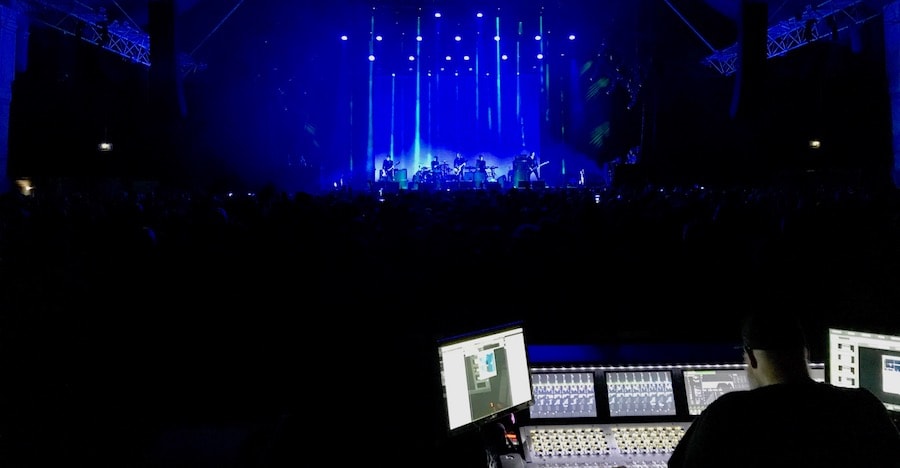
What plugins are you using on S6L?
The bulk of it is AAX, with Waves on key elements. For the first Young the Giant tour I didn’t run any Waves whatsoever even though I was fairly heavily reliant on Waves on the Profile. But when I moved over to Interpol, I decided to use Waves—and this was before the Waves card was available—so I only used Waves on output processing. Group compression and bus compression. Now I'm running SoundGrid within my plugin rack and I'm back to using Waves on key elements. The Waves card has definitely helped with my workflow. One screen for everything makes my life a lot easier—less things to stare at leaves me more things to listen to.
I also really like that it's not just a single plugin implementation. Like for my lead vocal I'm running three particular Waves plugins. I love being able to have that within that one SoundGrid instance—one instance in my plugin rack. It’s definitely helped my workflow. And it's great just having everything back on one screen and not having to bounce back and forth between multiple screens.
Currently I am using a lot of strip compressors, as they are functional and sound good.
As far as plugins are as follows:
- Kick out: Waves DBX 160
- Kick in and sub kick: strip compressors and gates
- Snare top: Empirical Labs Arouser
- Bass DI: Waves C6, black face CLA-76 into an L1
- Bass mic: Avid Smack!
- Guitars: bussed to sub groups with Waves API 550B eq and Waves Renaissance Axe
- Keys: strip compressors on the channels which are then bussed to a sub group with an Avid Pultec EQP1A into an Avid Fairchild 670 and then Crane Song Phoenix II
- Lead vocal: Waves C6 into Waves Renaissance compressor into Avid Reel Tape Saturation
- L/R: Waves C6 into Waves SSL bus compressor
- Effects plugins are Avid’s Reverb One, Pitch II, SansAmp PSA-1, and Mod Delay III
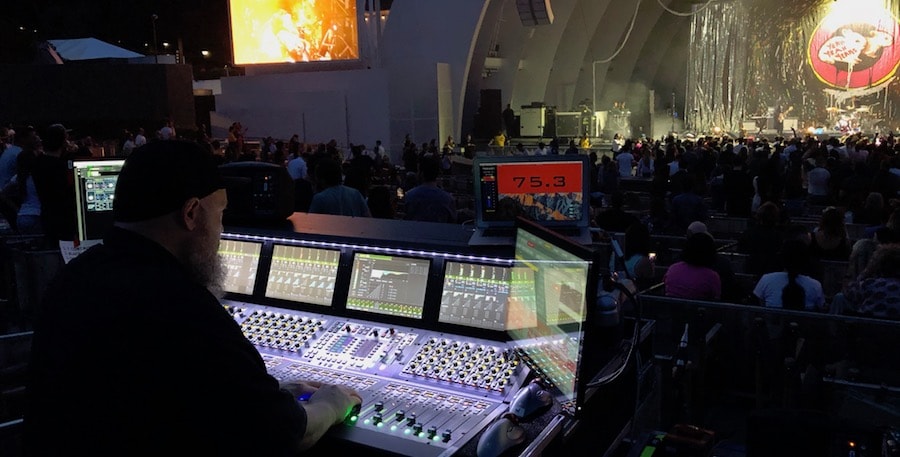
How do you use Pro Tools in your role as front-of-house engineer?
I love to track every show. I do a little bit of virtual playback through the PA whenever I can. In the afternoons after the band has finished sound check, I bring up Pro Tools and put the headphones on and I spend a couple of minutes working on things. I'm constantly taking notes and in this way I'm able to address things in my downtime maybe between soundcheck and showtime. And I take sessions home and I have Pro Tools on my laptop so I'm able to open sessions up and listen, create mixes if the band requires a mix for some particular reason. So I love the portability of it. I love how Virtual Soundcheck is now all of three button clicks away as opposed to a full console reset. It was a great idea and it was great on the Profile and now it's even better on the S6L. It's so streamlined now and it takes all of ten seconds to flip everything around. It's not uncommon for me to bounce back and forth between Virtual Playback and the stage rack three or four times during the day just because it's so simple.
I love not having to type anything whatsoever to set up a Pro Tools session. Traditionally I would have templates, but not having to type anything outside of a file name is really fantastic and just makes the whole thing quick, seamless. And for people that aren't terribly Pro Tools fluent, it makes things a lot easier also. You don't have to do anything. So kudos to you guys for even looking at that aspect of it and making that part of it that much simpler and more powerful as a result.
What are your thoughts about the expanded S6L Unified Live Sound Platform and the fact that there are more surface, engine and I/O options than ever?
While I have seen a handful of S6Ls as house consoles and I've seen a handful of them at festivals brought in, I'm really excited to now see the more compact version, to see versions that are going to come in at lower price points but still be compatible with everything. I love the idea of my show file being able to load in anything as opposed to some other companies where it's not quite as easy as they want you to believe it is. So I can't wait to start seeing the smaller-format S6L systems in venues around the world and to know that we're going to have 100 percent compatibility with show files. It makes absolute perfect sense.
I love the idea of how you guys and girls at Avid are building a family here as opposed to a one-off product. And that family goes both bigger and smaller, but yet everything is going to talk to each other. As somebody who started in clubs years ago and worked his way up, I care about what PAs and what consoles and what equipment smaller venues have. I still do smaller tours, and I do still find myself using house systems. I'd be completely psyched to walk into a house that has a compact S6L system and be able to load a show file and just go and not having to tweak things to get it to work properly. So I think great move on your part. Absolutely.
